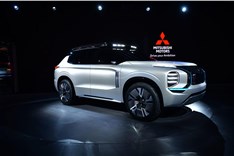Mitsubishi Cedia LPG
The Cedia LPG is well built, handles decently and is a spritely performer as well
Published on Sep 14, 2009 07:00:00 AM
42,924 Views
Follow us on



All this tech works well in the real world even if the numbers suggest a drop in power. The LPG Cedia, even in petrol mode, delivers 5bhp less than the regular or non-LPG Cedia which also has the benefit of being 70kg lighter.
In LPG mode, power drops by another 10bhp to 100bhp. It’s quite a drop but in normal driving, we simply couldn’t tell which mode we were driving in. In fact, our favourite pastime was toggling the switch between petrol and LPG and then covering it with our palms to play ‘guess the mode’ with the co-passenger. The transfer switch between two modes is a flimsy button mounted ahead of the gear lever. It’s well located but the green LED lights catch the glare and are difficult to read during the day.
The Cedia’s 2.0-litre engine is pretty refined and smooth but the extra weight and marginal drop in power have blunted the bi-fuel Cedia’s performance when compared to the regular model.
For town driving, you simply won’t have a problem chugging along in traffic. Driving in bumper-to-bumper traffic is easy, the engine pulling well from low rpm. There is never an occasion where you want to say ‘to hell with it’ and switch to the more powerful petrol mode. That’s because there’s barely any difference.
Scan the acceleration times and compare the two modes to see what we mean. The dash to 100kph comes up in 12.70 seconds in LPG mode, a scant 0.6sec slower than when burning petrol. In the crucial 20-80kph in-gear slog, there’s not much of a gap as well.
Even on the highway, there is enough grunt for overtaking in LPG mode and there is no tangible benefit in switching over to petrol to make a fast overtaking manoeuvre on a single-lane highway.
What about the running costs?. Topping up the 48-litre LPG tank costs only Rs 1,300, but the advantage is offset to some extent by the inherent lower efficiency of LPG. In petrol mode, we achieved 9.2kpl and 12.42kpl in the city and highway drive cycles respectively. That’s a reasonable figure for full-size saloon. In the LPG mode the efficiency drops dramatically to 6.4kpl and 11.1kpl respectively for the identical city and highway cycles. Use your calculator for the city cycle and this works out to a running cost of Rs 4.23 per kilometre compared to Rs 5.25 in petrol mode. That’s a considerable saving. The bigger issue is that an LPG outlet is not just round the corner and we had to hunt around to find one.
Copyright (c) Autocar India. All rights reserved.









Comments
Member Login
Personal Details
No comments yet. Be the first to comment.